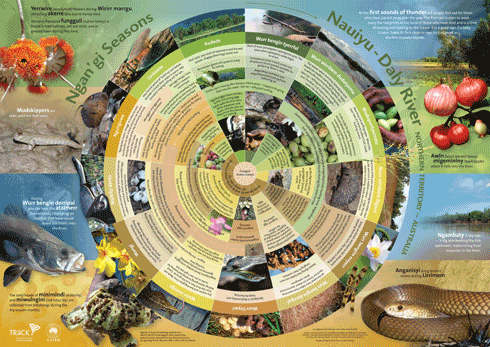
|
Published: 2 July 2012
The deeper riches of river country
At Nauiyu Nambiyu on the Northern Territory’s Daly River, Ngan’gi-speaking people observe the signs of Wirirr marrgu, or 'burn grass season'. Elder, Patricia Marrfurra McTaggart, says when the wet season ends, people go out harvesting fish, pig-nosed turtle, long-necked turtle, snapping turtle, echidna, rock python and water lilies. It is, she says, a season of plenty.
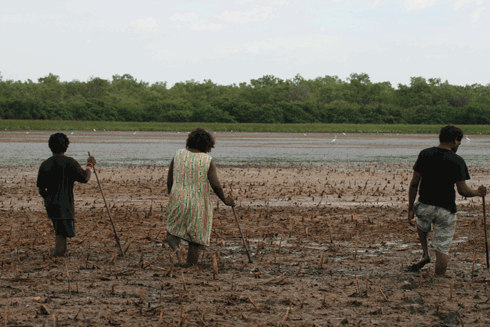
|
|
Turtle hunting at a Daly River billabong in the Northern Territory Credit: CSIRO
|
Patricia McTaggart is one of many Aboriginal people sharing their knowledge of country with a CSIRO research team – supported by the Tropical Rivers and Coastal Knowledge (TRaCK) research hub – documenting the value of healthy river systems to local communities.1
The team, led by Dr Sue Jackson, has just completed a three-year study into the socio-economic and cultural values that Indigenous people from the Daly River, Northern Territory, and the Fitzroy River, Western Australia, hold about water.
Team members visited households in the Daly and Fitzroy River areas 16 times over a two-year period to ask how often family members went fishing and hunting, who participated, the location, the total harvest, how much the household consumed and how much it shared.
This detailed information enabled the researchers to calculate the economic value of healthy rivers to surrounding communities.
They found that the aquatic wild food most commonly caught and harvested by the Daly River community included long-necked turtle, lotus lily, black bream, magpie goose, short-necked turtle, along with barramundi, spangled perch, water lily, water chestnut, mullet and catfish. The resources consumed by each household surveyed were estimated to be worth $69.17 (per fortnight), or 5.1 per cent of the median household income in the Daly River region.
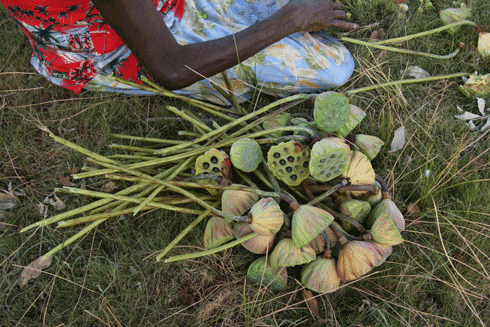
|
|
Lotus lily seed pods are eaten by the residents of Nauiyu Nambiyu community, Daly River, Northern Territory. Credit: CSIRO
|
But the economic worth of healthy rivers like the Daly to Indigenous communities would be even higher if the social and cultural significance of harvesting wild food were able to be included in the valuation, say the researchers. They also point out that many indigenous households have very low incomes, making bush tucker a vital part of family nutrition.
A key finding of the study is that resource use along the Daly varies markedly with the seasons. During the Wet (November to April), 44 per cent of the food gathered by the Daly River community came from fishing in the river, and only 1 per cent came from the billabong. The remainder came from fishing in the creeks and hunting.
With the advent of the Dry, there is less fishing in the river, and more in the billabongs. By the late dry season, 69 per cent of food gathering occurs in the billabongs, which rely on annual floodwaters to replenish them.
Such information is critical, say the researchers, because development – for example, the construction of dams for crop irrigation – can seriously disrupt seasonal flows, as can drawing groundwater from an aquifer in the dry season. The Daly River’s permanent flow is sustained through the long dry season by groundwater discharge.
‘Our TRaCK colleagues found that if farmers were to draw too much water during the dry season, this could put at risk key fish species such as black bream and barramundi,’ Dr Jackson says.
‘And we now know from our research how important these two fish species are to Aboriginal people. Close to a thousand black bream and barramundi were caught during the survey period by the households we interviewed.’
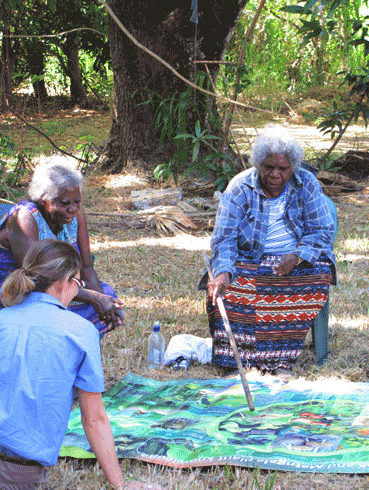
|
|
CSIRO’s Emma Woodward (bottom left) talking through the MalakMalak & Matngala Seasonal calendar with Rita Pirak (left) and Biddy Lindsay. Credit: CSIRO
|
The CSIRO work is part of a broader research program that is vital to sustainable water planning as pressure grows to develop the country’s northern water resources.
Dr Jackson says her team’s research was motivated by the under-valuation of Indigenous subsistence resource use and knowledge. She points out that although the National Water Commission has identified Indigenous rights, values and interests relating to water as a national priority, Indigenous ‘water uses’ are rarely explicitly addressed in water plans.
One of her team's aims was to identify Indigenous interests that related to the research. For example, when Ms McTaggart suggested drawing up a seasonal calendar, CSIRO researcher Emma Woodward grabbed the opportunity.
‘We gathered the information over the next 10 months or so, to make sure we were collecting the information within the seasons and as it was happening,’ explains Ms Woodward.
Ms McTaggart had been worried the local children were losing their language and felt it was ‘really vital that we have something written down on paper and the kids can see it and try and say the words and understand the background of the word’.
The information gathering process involved extensive consultation, according to Ms Woodward. ‘It was a very detailed and iterative process of going back and forth to the community, making decisions about what photos to have, the exact text what it should say, did I have the meanings right.
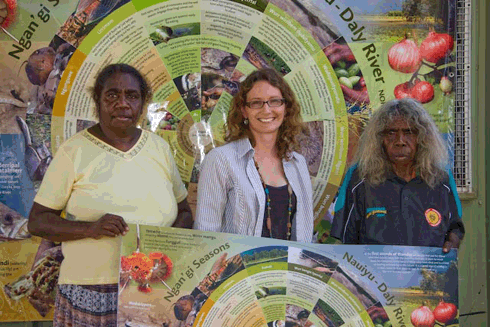
|
|
Nauiyu community leader, Patricia Marrfurra McTaggart, CSIRO’s Emma Woodward and Molly Yawulminy with the Ngan’gi Seasonal calendar developed by the Nauiyu community. The calendar was actually Ms TcTaggart’s idea, taken up by a team from CSIRO Ecosystem Sciences who had been studying Indigenous water values. Credit: CSIRO
|
‘We have had requests from schools right across northern Australia who have seen the calendar on our website and requested either class sets or copies they could incorporate into the curriculum.
‘That has stimulated further calendars with other Indigenous groups. We are now working with the sixth language group, the Gulumoerrgin from Darwin, on a seasonal calendar of their ecological knowledge.’
Ms Woodward adds that when people from the Daly community were given cameras and asked to take photos of important family and community activities, 95 per cent of the photos taken ‘related to aquatic places, whether it was hunting in family groups, visiting country, preparing food that had been caught from rivers and billabongs and turtles and fish and sharks, or older women demonstrating how food was to be prepared to younger children.’
Dr Jackson says her team’s work proves that researchers can gain significant benefits from working with Indigenous people.
‘They have a long-standing and deep connection to the landscape that we are interested in,’ she says.
‘Indigenous groups are committed to managing their country in the future, and so have a strong interest in exchanging knowledge, learning about science and learning about contemporary management approaches as well as teaching others about their methods and insights.’
Ms McTaggart, who has co-authored a scientific paper with the researchers, with another in the pipeline, declares the experience for her has been ‘100 per cent positive’.
‘I was really happy because the researchers that came spent a lot of time. It was an opportunity for me to try and work in with them.’
She said her community was very excited about the calendar, ‘with the younger ones, and people my age too, in their 40s or 50s, seeing how following the life cycle of the different animals that people are going to collect and plants that we want to go and look for, for bush tucker. People felt really excited and really happy that something was being done.’
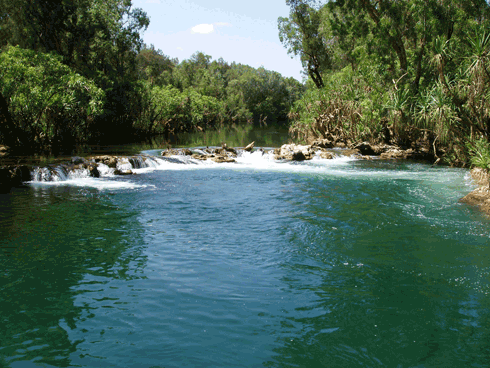
|
|
Daly River, Northern Territory Credit: CSIRO
|
|
While Indigenous people own nearly 20 per cent of Australia, they own less than 0.01 per cent of the water allocations. Yet water is vital to Indigenous social, cultural and the domestic economic activity – ensuring legal access to water means communities could create water-related businesses and employment in the future. But few legal mechanisms exist to allow that. |
The CSIRO team has been working with the Daly and Fitzroy River communities ‘to document their knowledge and to account for their pattern of resource use, and to value that,’ says Dr Jackson. |
Similar studies are under way in the Katherine and Roper Rivers of the Northern Territory, the Murray-Darling Basin, and in northern Queensland’s Mitchell River. The information will provide decision-makers with an additional set of issues to consider in the planning and development of water resources. |
Aware that Indigenous people were left out of the Murray Darling Basin’s water planning process, planners in northern Australia, along with Indigenous organisations like the Northern Australian Indigenous Land and Sea Management Alliance (NAILSMA) are experimenting with a new policy instrument, the strategic Indigenous reserve. |
|
The CSIRO has compiled seasonal calendars with six different Indigenous language groups. In the Ngan'gi Seasons Calendar, there are 13 seasons, some as brief as two weeks. |
The calendar largely revolves around the life cycle of the dominant local spear grass, known as wurr (Sarga spp.). |
For example, when wurr stalks start to die and turn reddish, it is a sign that the Dry is approaching. The next season begins after the wurr seeds turn brown and start to fall. The following season occurs when all the seeds have fallen and big storms knock over the grass. The drying of the speargrass, now ready to burn, heralds a new season, while the next is prompted by the actual burning of the grass. |
Because each season occurs after a particular change in the vegetation, it is not possible to link them tightly to European seasons. And some indicators – like the peeling bark of the ghost gum telling you that the bull sharks are fat or the flowering of the red kapok indicating that freshwater crocodiles have laid their eggs – do not follow orthodox science. |
More information
Indigenous socio-economic values and river flows: report summary.
1 The research was carried out under the auspices of the Tropical Rivers and Coastal Knowledge (TRaCK) Research Hub with funding from the National Water Commission and the Federal Department of Environment, Water, Sustainability, Population and Communities.


